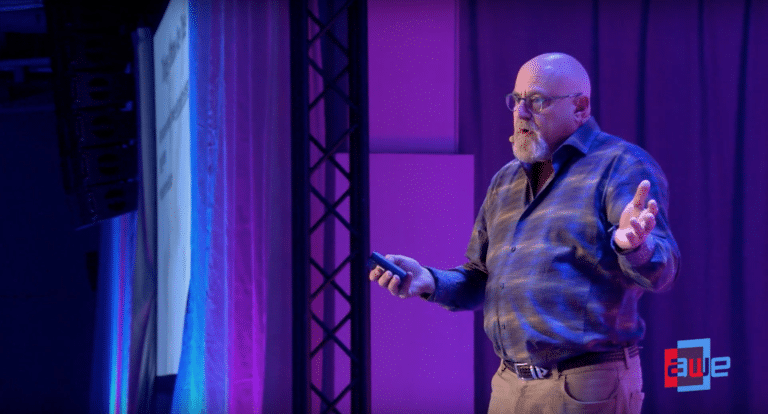
XR Talks is a series that features the best presentations and educational videos from the XR universe. It includes embedded video, as well as narrative analysis and top takeaways. Speakers’ opinions are their own.
One of our favorite exercises is to look at historical lessons to gain insights on tech’s future path. Another one of our favorite things is Charlie Fink’s insights on the wide world of XR. Combine those two things and you get Fink’s talk at AWE Europe — a sort of XR state of the union.
Drawing from the rich base of insights from his first book (our review here), and from his second book (currently underway*), we get an informed position on what’s what. Part of that is the course of tech revolutions like XR, which — as we heard recently from Jeri Ellsworth — take time.
“From when I was a kid, where we only had three [television] channels, to today where we’re awash in information… it was 50 years,” he said from the LED-lit AWE stage in Munich (video below). “So let’s have some perspective here because this is a long path.”

As for what will drive innovation and adoption, there are of course several factors. But chief among them are things that appeal to or enhance our humanity. That includes social, as already shown by prevalent AR use cases like selfie lenses. As Fink likes to say, people are the killer app.
“The path is really not about devices, but about the augmentation of mankind and our human connection,” he said. “The phone in my pocket is augmenting me. I can’t remember anything without that phone anymore. We’re looking, in short, to be connected to others.”
Another factor is data. A central theme of Fink’s upcoming book Convergence is that the world will be painted with data. This invokes the AR cloud, which will let AR devices perform by tapping into geospatially-anchored data layers. But it will also need smart architecture and interoperability.
“Right now there are lots of AR clouds,” he said, in similar fashion to our ‘plurality’ construct. “But the siloing of all that content will make it very difficult to access it when you want it. So there has to be some common language, sort of like the way search is possible because of HTML.”

These AR cloud principles are carried by the Open AR Cloud Organization and Ori Inbar’s “spatial Wikipedia.” Fink’s concept of a Universal Visual Browser (UVB) is likewise a smart way to look at how our devices will interact with AR data layers. But he admits it needs a filtration system.
“The [UVB] will be useless without a filter because all you’ll see is pornography, pictures of food and selfies.” he said. “What you want is timely contextual information that is personal to you, so you want to see pictures of food from your friends on Facebook, [not] somebody else’s selfies.”
Beyond data, form factor is a key variable. Though it scales, mobile AR is just a step (and a clunky one) towards a wearable contextual computer. That will likely be glasses, but also a more holistic sensory immersion that integrates other senses like our favorite AR wild card, sound.
“Maybe glasses won’t be the final form factor,” posited Fink. “Maybe I’ll be wearing a lapel pin that provides the computer vision to my ear buds, so that I don’t necessarily need facial recognition to have your face recognized in that way. Maybe Alexa just whispers in my ear.”

As for VR, it shares AR’s technological underpinnings like optics and positional tracking. And there will be convergence, such as Oculus Quest’s mobility and pass-through cameras to bring in the real world. But we shouldn’t conflate AR & VR too much, as they’re driven by different needs.
“VR is deeply rooted in us to want to be fully present in imaginary worlds,” Fink said, tapping into his career in media & entertainment. “AR, on the other hand, is a tool. It’s like the steam engine or the computer: we use it to make ourselves smarter and better and faster.”
But VR also lacks a focused consumer value proposition. Beyond gaming, there isn’t really one mass-relevant killer app. That could be “putting us in the movie” per Disney theme parks’ initial playbook, or some other function that makes it a must-have. Again, we go to historical lessons.
“In 1994, people didn’t think they needed a PC at home,” said Fink. “All it did was run expensive CD-roms and allowed you to do work at home which nobody had a tremendous interest in. But when it met the internet and it met e-commerce, people said ‘Oh my God, I have to have that’.”
See the full talk below.
*Editor’s note: The author of this post has contributed a chapter to Fink’s upcoming book. No money changed hands for the production of this article.
For deeper XR data and intelligence, join ARtillery PRO and subscribe to the free AR Insider Weekly newsletter.
Disclosure: AR Insider has no financial stake in the companies mentioned in this post, nor received payment for its production. Disclosure and ethics policy can be seen here.
Header image credit: AWE, YouTube
